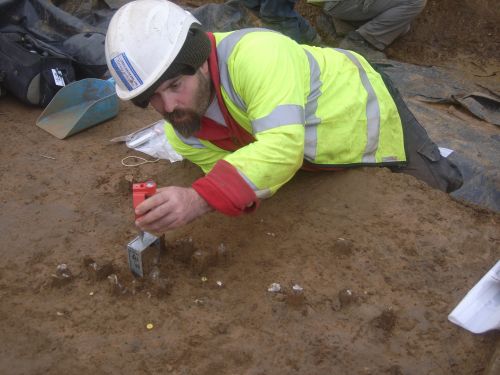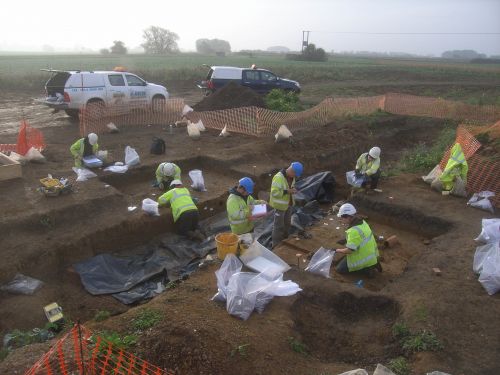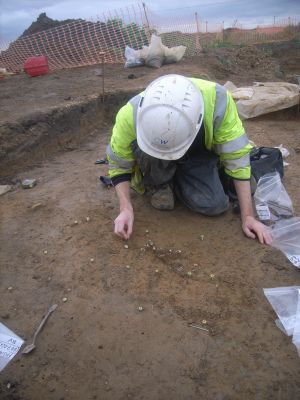Archaeologists working on a 21st century highways project in Nottinghamshire have found evidence for Ice Age hunters dating back to the end of the last Ice Age, over 12 thousand years ago.
Work on the A46 Newark-Widmerpool has not just been about building for the future but exploring the past. Archaeological excavations have found Bronze Age burials and part of Roman town but the archaeologists are most excited about one square metre littered with tiny bits of broken flint. They are traces of an ancient campsite.
Chris Ellis, one of the leaders of Cotswold Wessex Archaeology team responsible for the dig at Farndon Fields near Newark explained ‘We have found the remains of a campsite that was used during one of the warmer periods that punctuated the last Ice Age. In these warmer periods, or ‘Interstadials’, modern humans, were able to visit regions that had just been too cold to live in. These people came from the east and south but so much water was still locked up in the Ice Caps that the North Sea did not yet exist. They could just keep on walking.’
Experts think that these Ice Age hunters lived in close harmony with the wild animals that were their prey. They followed herds of reindeer and wild horses as they migrated through an environment that was like a polar desert summer. The hunters set up temporary camps and the site at Farndon Fields is close to where the River Devon flows into the River Trent, a place that would have provided a range of habitats and a rich menu of wild foods.
Trial works in advance of the new road identified traces of these ancient remains. As a result the design of the route was changed to avoid them but because the campsites were returned to year after year, their remains do not have a neat boundary. So the Highways Agency funded the painstaking excavation. This yielded a scatter of flints dating to the Interstadial. As they have been found in the open rather than in cave they represent exceptionally rare finds.
Most traces from these times are from caves that provided natural shelters. And they have also protected the fragile remains from destruction by modern ploughing. Some of the most famous finds from Britain that date to this time have been found in Creswell Crags, a limestone gorge honeycombed with caves, 33 kilometres, or just two or three days walk from Farndon Fields. These caves have also produced the oldest cave art in Britain dating back to the same Late Glacial Interstadial as the flints from Farndon Field.
Critically, the flints found at Farndon Fields are very similar to those found in the caves at Creswell Crags and this dating is backed up by Optically Stimulated Luminescence a technique that shows when the soil was last exposed to sunlight. This demonstrates that the hunters did not only live in caves. Instead they followed herds of animals as they moved between the lower and higher ground.
Their stone tools reflect this nomadic lifestyle. Thin pieces of flint were carefully removed from larger nodules by hitting or ‘knapping’ the nodule. These flint flakes were carried on hunting trips, making sure the Ice Age people had the kit to make the exact tools they needed. Amongst the thin scatter of finds at Farndon Fields was a small concentration of tiny bits of flint. It is the waste left behind an Ice Age hunter.
Dr Andrew Fitzpatrick of Wessex Archaeology explained ‘It seems as if 12,000 years ago someone sat here knapping flints. While they worked, tiny splinters of flint landed between their legs. When they stood up, they took with them the pieces they wanted for tools. They just left the rubbish where it had fallen. Soon after that the River Devon flooded and when the waters fell they left behind a thin layer of silt that covered the flints, protecting them until today. But by then the Ice Age hunter had walked into history.’
Listen to Phil Harding discuss this site on BBC Radio 4's Today show.
Further information
Balfour Beatty is building the new road for the Highways Agency. The archaeological works have been undertaken by a joint venture between Cotswold Archaeology and Wessex Archaeology working with Scott Wilson Consultants. Trent and Peak Archaeology did earlier stages of work at Farndon Fields
Balfour Beatty is building the new road for the Highways Agency. The archaeological works have been undertaken by a joint venture between Cotswold Archaeology and Wessex Archaeology working with Scott Wilson Consultants. Trent and Peak Archaeology did earlier stages of work at Farndon Fields


